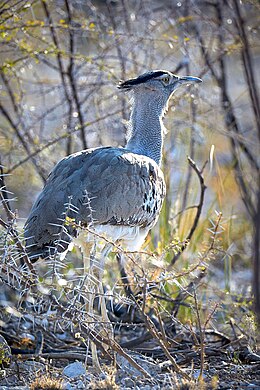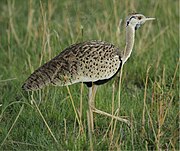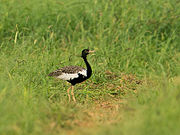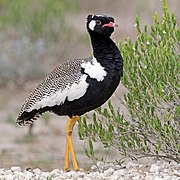Bustard
| Bustards | |
|---|---|

| |
| Kori bustard | |
| Scientific classification | |
| Domain: | Eukaryota |
| Kingdom: | Animalia |
| Phylum: | Chordata |
| Class: | Aves |
| Clade: | Otidimorphae |
| Order: | Otidiformes Wagler, 1830 |
| Family: | Otididae Rafinesque, 1815 |
| Genera | |
| Synonyms | |
| |
Bustards, including floricans and korhaans, are large, terrestrial birds living mainly in dry grassland areas and in steppe regions. They range in length from 40 to 150 cm (16 to 59 in). They make up the family Otididae (/oʊˈtɪdɪdiː/, formerly known as Otidae).[1]
Bustards are omnivorous and opportunistic, eating leaves, buds, seeds, fruit, small vertebrates, and invertebrates.[2] There are 26 species currently recognised.
Etymology
[edit]The word bustard comes from the Old French bistarda and some other languages: abetarda (pt), abetarda (gl), avutarda (es) used for the great bustard. The naturalist William Turner listed the English spelling "bustard" and "bistard" in 1544.[3][4]
All of the common names above are derived from Latin avis tarda or aves tardas given by Pliny the Elder,[5][a] these names were mentioned by the Pierre Belon in 1555 and Ulisse Aldrovandi in 1600.[6][7] The word tarda comes from tardus in Latin meaning "slow" and "deliberate",[8] which is apt to describe the typical walking style of the species.[9]
Floricans
[edit]Some Indian bustards are also called floricans. The origin of the name is unclear. Thomas C. Jerdon writes in The Birds of India (1862)
I have not been able to trace the origin of the Anglo-Indian word Florikin, but was once informed that the Little Bustard in Europe was sometimes called Flanderkin. Latham gives the word Flercher as an English name, and this, apparently, has the same origin as Florikin.
— Jerdon's Birds of India, 2nd ed. ii. 625.
The Hobson-Jobson dictionary, however, casts doubt on this theory stating that
We doubt if Jerdon has here understood Latham correctly. What Latham writes is, in describing the Passarage Bustard, which, he says, is the size of the Little Bustard: Inhabits India. Called Passarage Plover. ... I find that it is known in India by the name of Oorail; by some of the English called Flercher. (Suppt. to Gen. Synopsis of Birds, 1787, 229). Here we understand the English to be the English in India, and Flercher to be a clerical error for some form of floriken.
Taxonomy
[edit]The family Otididae was introduced (as Otidia) by the French polymath Constantine Samuel Rafinesque in 1815.[10][11][12] Otididae and before that Otidae come from the genus Otis given to the great bustard by the Swedish naturalist Carl Linnaeus in the tenth edition of his Systema Naturae in 1758,[13] it comes from the Greek word ὠτίς ōtis.[14][15]
| Phylogeny of Otididae[16] | ||||||||||||||||||||||||||||||||||||||||||||||||||||||||||||||||||||||||||||||||||||||||||||||||||||||||||||||||||||||||||||||||||||||||||||||||
|
Family Otididae[17][citation needed]
| Image | Genus | Living species |
|---|---|---|

|
Lissotis Reichenbach 1848 |
|

|
Neotis Sharpe 1893 |
|

|
Ardeotis Le Maout 1853 |
|

|
Tetrax Forster 1817 |
|

|
Otis Linnaeus 1758 |
|

|
Chlamydotis Lesson 1839 |
|

|
Houbaropsis Sharpe 1893 |
|

|
Sypheotides Lesson 1839 |
|

|
Lophotis Reichenbach 1848 |
|

|
Heterotetrax Sharpe 1894 |
|

|
Eupodotis Lesson 1839 |
|

|
Afrotis Gray 1855 |
|
- Extinct genera
- Genus †Gryzaja Zubareva 1939
- †Gryzaja odessana Zubareva 1939
- Genus †Ioriotis Burchak-Abramovich & Vekua 1981
- †Ioriotis gabunii Burchak-Abramovich & Vekua 1981
- Genus †Miootis Umanskaya 1979
- †Miootis compactus Umanskaya 1979
- Genus †Pleotis Hou 1982
- †Pleotis liui Hou 1982
Description
[edit]Bustards are all fairly large with the two largest species, the kori bustard (Ardeotis kori) and the great bustard (Otis tarda), being frequently cited as the world's heaviest flying birds. In both the largest species, large males exceed a weight of 20 kg (44 lb), weigh around 13.5 kg (30 lb) on average and can attain a total length of 150 cm (59 in). The smallest species is the little brown bustard (Eupodotis humilis), which is around 40 cm (16 in) long and weighs around 600 g (1.3 lb) on average. In most bustards, males are substantially larger than females, often about 30% longer and sometimes more than twice the weight. They are among the most sexually dimorphic groups of birds. In only the floricans is the sexual dimorphism the reverse, with the adult female being slightly larger and heavier than the male.[citation needed]
The wings have 10 primaries and 16–24 secondary feathers. There are 18–20 feathers in the tail. The plumage is predominantly cryptic.[2]
Behaviour and ecology
[edit]Bustards are omnivorous, feeding principally on seeds and invertebrates. They make their nests on the ground, making their eggs and offspring often very vulnerable to predation. They walk steadily on strong legs and big toes, pecking for food as they go. Most prefer to run or walk over flying. They have long broad wings with "fingered" wingtips, and striking patterns in flight. Many have interesting mating displays, such as inflating throat sacs or elevating elaborate feathered crests. The female lays three to five dark, speckled eggs in a scrape in the ground, and incubates them alone.[19]
Evolution
[edit]Genetic dating indicates that bustards evolved c. 30 million years ago in either southern or eastern Africa from where they dispersed into Eurasia and Australia.[20]
Status and conservation
[edit]
Bustards are gregarious outside the breeding season, but are very wary and difficult to approach in the open habitats they prefer.[21] Most species are declining or endangered through habitat loss and hunting, even where they are nominally protected.
United Kingdom
[edit]The birds were once common and abounded on the Salisbury Plain. They had become rare by 1819 when a large male, surprised by a dog on Newmarket Heath, sold in Leadenhall Market for five guineas.[22] The last bustard in Britain died in approximately 1832, but the bird is being reintroduced through batches of chicks imported from Russia.[21] In 2009, two great bustard chicks were hatched in Britain for the first time in more than 170 years.[23] Reintroduced bustards also hatched chicks in 2010.[24]
Notes
[edit]- ^ "proximae iis sunt quas Hispania aves tardas appellat, Graecia ωτιδος damnatas in cibis; emissa enim ossibus medulla odoris taedium extemplo sequitur." [Next to these are the birds that Spain calls tardae and Greece otides, which are condemned as an article of diet, because when the marrow is drained out of their bones a disgusting smell at once follows.][5]
References
[edit]- ^ Gill, Frank; Donsker, David; Rasmussen, Pamela, eds. (2019). "Turacos, bustards, cuckoos, mesites, sandgrouse". World Bird List Version 9.2. International Ornithologists' Union. Retrieved 26 June 2019.
- ^ a b del Hoyo, J. Elliott, A. & Sargatal, J. (editors). (1996) Handbook of the Birds of the World. Volume 3: Hoatzin to Auks. Lynx Edicions. ISBN 84-87334-20-2
- ^ Turner, William (1903) [1544]. Turner on birds: a short and succinct history of the principal birds noticed by Pliny and Aristotle first published by Doctor William Turner, 1544 (in Latin and English). Translated by Evans, A.H. Cambridge: Cambridge University Press. pp. xvi, 130–131.
- ^ Turner, William (1544). Avium praecipuarum, quarum apud Plinium et Aristotelem mentio est, brevis et succincta historia (in Latin). Cambridge: Ioan. Gymnicus. pp. 72–73.
- ^ a b Pliny Natural History III Libri VIII-XI. The Loeb Classical Library. Translated by Rachham, H. Cambridge, Massachusetts: Harvard University Press. 1967. pp. 328–329.
- ^ Belon, Pierre (1555). L'histoire de la natvre des oyseavx : avec levrs descriptions, & naïfs portraicts retirez du natvrel, escrite en sept livres (in French). Paris: Gilles Corrozet. pp. 235–237.
- ^ Aldrovandi, Ulisse (1637) [1600]. Vlyssis Aldrovandi philosophi ac medici Bononiensis historiam naturalem in gymnasio Bononiensi profitentis, Ornithologiae (in Latin). Vol. 2. Bononiae (Bologna, Italy): Apud Nicolaum Tebaldinum. p. 85.
- ^ Lewis, Charlton T.; Short, Charles (1879). "tardus". A Latin Dictionary. Perseus Digital Library.
- ^ "Great Bustard (Otis tarda) – Information on Great Bustard". Encyclopedia of Life. Retrieved 21 August 2012.
- ^ Rafinesque, Constantine Samuel (1815). Analyse de la nature ou, Tableau de l'univers et des corps organisés (in French). Vol. 1815. Palermo: Self-published. p. 70.
- ^ Bock, Walter J. (1994). History and Nomenclature of Avian Family-Group Names. Bulletin of the American Museum of Natural History. Vol. 222. New York: American Museum of Natural History. pp. 137, 252. hdl:2246/830.
- ^ "Taxonomic lists- Aves". Retrieved 30 December 2015.
- ^ Linnaeus, Carl (1758). Systema Naturae per regna tria naturae, secundum classes, ordines, genera, species, cum characteribus, differentiis, synonymis, locis (in Latin). Vol. 1 (10th ed.). Holmiae (Stockholm): Laurentii Salvii. p. 154.
- ^ Jobling, James A. (2010). Helm Dictionary of Scientific Bird Names. London, UK: Christopher Helm. p. 286. ISBN 978-1-4081-3326-2. OCLC 659731768.
- ^ Liddell, Henry George; Scott, Robert (1940). "ὠτίς". A Greek-English Lexicon. Perseus Digital Library.
- ^ Boyd, John (2007). "Otididae" (PDF). John Boyd's website. Retrieved 30 December 2015.
- ^ "Turacos, bustards, cuckoos, mesites, sandgrouse". IOC World Bird List. v13.2. Retrieved 21 October 2023.
- ^ MacQueen's bustard has recently been split from the houbara bustard as a full species.
- ^ Archibald, George W. (1991). Forshaw, Joseph (ed.). Encyclopaedia of Animals: Birds. London: Merehurst Press. pp. 98–99. ISBN 978-1-85391-186-6.
- ^ Pitra, C.; Lieckfeldt, D.; Frahnert, S.; Fickel, J. (2002). "Phylogenetic relationships and ancestral areas of the bustards (Gruiformes: Otididae), inferred from mitochondrial DNA and nuclear intron sequences". Molecular Phylogenetics and Evolution. 23 (1): 63–74. doi:10.1006/mpev.2001.1078. PMID 12182403.
- ^ a b Bota, G., J. Camprodon, S. Mañosa & M.B. Morales (Editores). (2005). Ecology and Conservation of steppe-land birds. Lynx Editions. Barcelona ISBN 84-87334-99-7; 978-84-87334-99-3.
- ^ The National Cyclopaedia of Useful Knowledge, Vol.III, London, (1847) Charles Knight, p.963
- ^ Bird Guides 2009. The first Great Bustard chicks in the UK Bird Guides, June 2009.
- ^ Biodiversity Lab 2010. Reintroduced Great Bustards Breed Again Archived 2017-01-25 at the Wayback Machine The Biodiversity Lab, University of Bath.
Bibliography
[edit]- Bota, Gerard, et al. Ecology and Conservation of Steppe-Land Birds. International Symposium on Ecology and Conservation of Steppe-land birds. Lynx Edicions 2005. 343 pages. ISBN 84-87334-99-7.
- Chisholm, Hugh, ed. (1911). . Encyclopædia Britannica (11th ed.). Cambridge University Press.
- Knox, Alan G.; Martin Collinson; Andreas J. Helbig; David T. Parkin; George Sangster (October 2002). "Taxonomic recommendations for British birds". Ibis. 144 (4): 707–710. doi:10.1046/j.1474-919X.2002.00110.x.
- Sibley, Charles G.; Jon E. Ahlquist (1990). Phylogeny and Classification of the Birds: A Study in Molecular Evolution. New Haven: Yale University Press. ISBN 978-0-300-04085-2.
- Hackett, SJ; et al. (2008). "A phylogenomic study of birds reveals their evolutionary history". Science. 320 (5884): 1763–1768. Bibcode:2008Sci...320.1763H. doi:10.1126/science.1157704. PMID 18583609. S2CID 6472805.
- Jarvis, Erich D; et al. (2014). "Whole-genome analyses resolve early branches in the tree of life of modern birds". Science. 346 (6215): 1320–1331. Bibcode:2014Sci...346.1320J. doi:10.1126/science.1253451. PMC 4405904. PMID 25504713.
External links
[edit]- Bustard videos on the Internet Bird Collection
